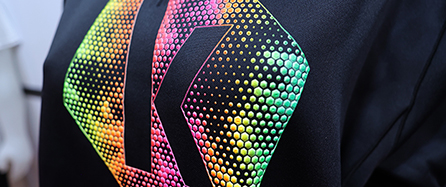
Category: SERVICES
Country: United Kingdom
As fabric printing becomes more popular, with textiles used for solutions like wide-format and garment printing, what should you consider in this vast and potentially lucrative market?
David Osgar
Shining a spotlight on the industry
Monday, 30 Jan 2023 15:13 GMT
Fashioning the future
In the world of print and signage, many key areas are driving the way in which businesses operate and are influencing the products they output. Sustainability, customisation, availability, and quality are all at the forefront of any product, but none more so than textiles.
Sustainability may often seem like a buzz word or trend, but regardless of PR spins, eco-credentials are the driving force behind the majority of products and business practices today.
The bad reputation of the fashion industry over the past few years has led to many headlines citing the sector as one of the world’s biggest pollutants. While publications such as The New York Times and environmental experts have debunked this theory, the statistics and behaviours surrounding fast fashion have been in dire need of change for a long time.
This coupled with the increased popularity of e-commerce, customisation, and uniqueness has meant textile and garment printing has become more and more relevant.
Due to the overlap of many sign-making practices, as well as the relationship between textiles and print, textile and garment printing has long been a lucrative area for those who supply the display industry.
A recent example of this evolution can be found with Bristol-based business, 2601, which moved further into large-format textile printing with the investment of new technology from Mimaki and CMYUK.
The company’s wish to bring textile printing in-house in order to provide large backdrops for film and TV meant investing in new equipment and materials. Research and training into textiles, and best practices meant the business was able to better bolster its output and provide new solutions for interior decoration, as well as large-format print.
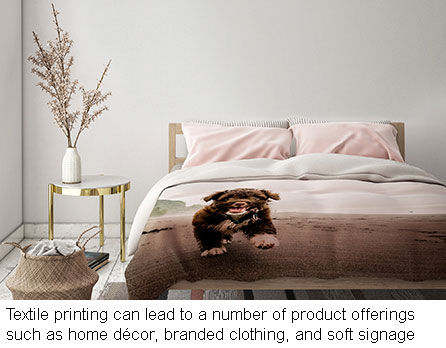 Textile printing can lead to a number of product offerings such as home décor, branded clothing, and soft signage
Textile printing can lead to a number of product offerings such as home décor, branded clothing, and soft signage
With many options available for businesses such as garment printing, wide-format textiles, and interior decoration, let’s look at the key advice and focus points to look into in 2023.
Where to start?
In order to better understand the technology and sectors of textile printing, it is also important to understand the trends and areas of growth in the marketplace.
Alex Mighall, product marketing manager at R A Smart CAD & Machinery, has seen a variety of solutions and trends impact the industry thanks to the company’s knowledge of printing and the range of machinery it offers.
Mighall explains: “R A Smart was originally established as a bespoke manufacturer of specialist short run textile printing equipment but has since become a large and well-known supplier of digital large-format printing solutions.
“The company bared witness to the pioneering days of digital textile print technology in the late 1990s and has partnered with the leading machine manufacturers supplying and supporting customers throughout the UK and Ireland.”
R A Smart has a long and rich history in printed textiles as not only a supplier of equipment, but also as a commission screen maker, printer, and weaver. In 2022 the company celebrated its 50th year in business, leading to its reputation and wealth of knowledge.
Mighall says: “We’re proud to be partnered with leading machinery manufacturers including Mimaki, HP, Fujifilm, Transmatic, Polytech, and more to bring our customers the latest in digital print technology.”
Discussing investable technologies and the industry as a whole, Mighall comments: “Textile printing is one of the fastest growing sectors in wide-format print. The market is heading into a ‘boom phase’ and there’s a great amount of potential to capitalise on. Within textile printing itself, dye-sublimation is one of, if not the, most popular print methods. It’s a perfect starting point because it offers a solution for a vast variety of applications – from sportswear to soft signage – with a relatively easy process.
"Textile printing is one of the fastest growing sectors in wide-format print. The market is heading into a ‘boom phase’ and there’s a great amount of potential to capitalise on”
Mighall points out that many wide-format companies can already enter textile printing with the addition of a heat press and an existing vinyl printer and/or cutter. “In my opinion, the HP Stitch S500 is a fantastic place to start. Partner this with a Transmatic calender heat press and you’ll have a 1.6m solution capable of producing stunning prints by the roll.”
For businesses after a larger machine, Mighall suggests the 3.2m-wide HP Stitch S1000, adding: “It comes with a built-in colour spectrophotometer for consistent results and the ability to print two rolls of 1.6m material at the same time. Plus, it’s the only dye-sub printer on the market with thermal print heads, meaning no need for expensive engineer visits.”
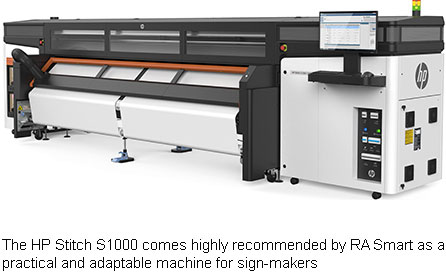 The HP Stitch S1000 comes highly recommended by RA Smart as a practical and adaptable machine for sign-makers
The HP Stitch S1000 comes highly recommended by RA Smart as a practical and adaptable machine for sign-makers
Research into this sector is certainly key as investing in certain materials and machinery drastically affects your quality and workflow if not executed correctly.
Iain Clasper-Cotte, managing director at FaberExposize/Northern Flags, states: “Fabrics that appear to have the same specifications can print very differently, so unlike UV or Latex printing where you can almost print out of the box, fabric takes a lot of trial and error to select the right substrates and to develop profiles that deliver the right results.”
As a large provider of wide-format print in the UK, FaberExposize has garnered a great deal of expertise in fabric printing, having worked for a number of the world’s biggest print management, advertising, sports, and event companies Clasper-Cotte adds: “We started with inline fixation printers and while they look straightforward, the limitations of control and flexibility meant we actually sold them after only 18 months and moved to separate sublimation with our Monti Antonio and Klieverik machines.
“It was an expensive learning process. In view of this I would recommend you use trade printers to ensure that you have a market before making the investment.”
FaberExposize UK is a part of the FaberExposize group, a large European display network with factories across the world offering a range of wide-format products. The company’s sister business Northern Flags is a specialist in flags, flagpoles, pull up banners, fabric banners, and automotive display.
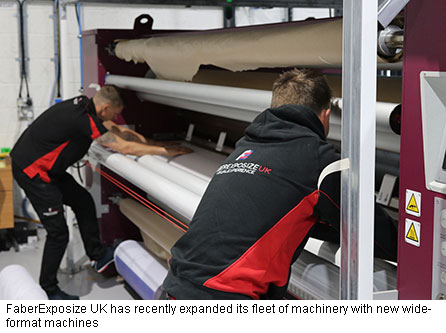 FaberExposize UK has recently expanded its fleet of machinery with new wide-format machines
FaberExposize UK has recently expanded its fleet of machinery with new wide-format machines
With this relationship, FaberExposize was able to utilise resources to effectively offer the widest range of products possible before investing in new kit. But aside from owning the kit, Clasper-Cotte emphasises the importance of training.
“There is definitely more of an art to it than with UV, but when you master it, the results are well worth the effort and the clients love the quality and greater robustness of the end product,” says Clasper-Cotte. “The biggest bit of advice is when selecting your hardware partner carry out due diligence on the support. Speak to other customers. If there is poor support, then your people will struggle, and your output will become unreliable.”
Where to expand?
With big shifts in the marketplace due to the pandemic, cost of living, e-commerce, and new focuses on sustainability, new trends and opportunities have arisen.
Speaking about what he believes to be the biggest opportunity in 2023, Mighall cites tension framing systems as products that can be incorporated into/or expand a textile offering.
“Essentially it involves stretching a printed textile over a frame by stitching a silicon edge onto their graphics. It’s a highly sustainable method to use, especially when compared to traditional stand and display building techniques. The frames are often manufactured from aluminium, like our REXframe solution, and can be re-used or 100% recycled.”
Despite the advantages new machinery and solutions can bring your business, the running cost of these processes are also important to consider, especially considering the current rise in energy prices.
Clasper-Cotte explains: “With dye-sublimation printing, the calender machine where the print is ‘baked’ consumes a significant amount of energy whenever it is switched on as it needs to heat up and maintain a specific temperature. Investing in such machinery needs to be considered carefully with sustainability at the forefront of every decision.”
Another important element to consider is inks, especially when viewed from the point of view of sustainability. Clasper-Cotte adds: “Over the past year we have switched to water-based Greenguard certified inks for both UV and dye-sub printing as they do not contain chemicals like chlorofluorocarbons (CFCs) or other solvents that might emit volatile organic compounds (VOCs).
Clasper-Cotte concludes: “Whatever the investment, businesses should aim to reduce their environmental impact. Personally, I would not advise on inline fixation based on our experiences (I know others may disagree).
“If you can afford it, always buy a bigger calender than you need so it can cope with expansion. Luckily, we invested in one of the largest capacity machines made by Monti Antonio, and now it is sublimating three high-volume printers with over 600sq m an hour of capacity.”
But while Mighall and Clasper-Cotte have alluded to expanding into wide-format solutions, many businesses will still find success in garment and apparel printing. As mentioned previously by Mighall, print and signage companies can add a machine like a heat press to existing equipment in order to expand a company’s offering.
Phil Oakley, director of Kornit Digital UK and Ireland, adds: “Highly specialised cutting systems such as those produced by Kornit partners like Gerber (a Lectra company) and Zünd, as well as the growing range of design applications, make it easier and more efficient than ever to transform custom fabrics into high-quality, ready-to-wear apparel.”
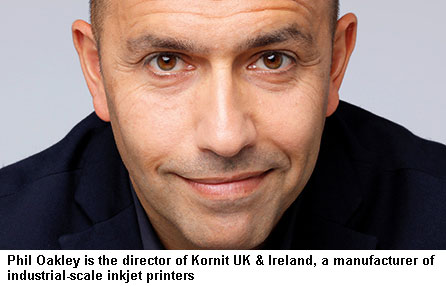 Phil Oakley is the director of Kornit UK & Ireland, a manufacturer of industrial-scale inkjet printers
Phil Oakley is the director of Kornit UK & Ireland, a manufacturer of industrial-scale inkjet printers
Discussing the need for diversity in times of crisis, Oakley says: “Kornit direct-to-garment production systems are more capable than ever. They require less energy, floorspace, labour, and materials and have created opportunities for commercial print businesses to diversify and grow in the face of a volatile, unpredictable marketplace that’s increasingly paperless”.
New avenues
In a world where sustainability is at the forefront and industries must ebb and flow to adapt to ever-growing changes, adopting new methods of trade and production can vastly help a business, especially if certain materials or solutions are less popular than before.
Provider of industrial-scale inkjet printers for use in the world of fabrics and finished garments, Kornit Digital has endured in the industry through its innovations, and dedication to quality and workflow.
Oakley states: “The ability to imprint garments opens new sales channels and enables a diversification that empowers the business with an agility when demand evolves or shifts suddenly. It enables fulfilment of a growing marketplace for custom, personalised, and otherwise bespoke goods, driven by a web-enabled world of creators who demand fast, responsibly made, and high-quality fulfilment of their inspirations.”
As a manufacturer of garment printers, Kornit has ensured it uses safe, sustainable proprietary inks and fixations, and enables an on-demand production model that eliminates waste. Machines are able to print on natural fabrics and polyester and poly-blends, in order to achieve a greater variety of achievable products.
O Factoid: Methods of fabric printing include direct-to-garment (DTG), direct-to-fabric (DTF), heat transfer, sublimation printing, and screen printing O
In order to best service this market, Oakley encourages businesses to keep on top of the latest trends in order to avoid being left behind. “Sportswear is booming right now, and with our Kornit Atlas MAX Poly, producers finally have the capability to deliver an unlimited number of designs and effects on team sports and athleisure garments.”
Oakley adds: “Producers tapping into the growing range of online design apps and social media channels can reap an ever wider base of potential customers, with more and more creators seeking fulfilment of their creations.
Whether it’s apparel, signage, home goods, or anything else requiring custom textile decoration, including uncut materials to be used as they wish.”
A large part of keeping up with trends and reacting to them is ensuring your business is actively engaged with online activity. Since the emergence of Covid-19, e-commerce has become an even bigger market than it was previously.
The apparel industry has a huge place in the online marketplace largely thanks to its convenience and variety. In order to tap into this part of the market, Oakley comments: “The e-commerce economy increasingly requires a reactiveness for which traditional print mechanisms are largely ill-suited.
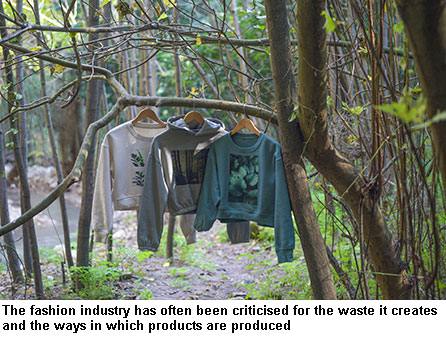 The fashion industry has often been criticised for the waste it creates and the ways in which products are produced.
The fashion industry has often been criticised for the waste it creates and the ways in which products are produced.
“When a trend emerges, or a major event takes place that creates new opportunities for personalised expression, you need a fast solution to capitalise in the moment, and that is digital’s sweet spot. The market is increasingly data-driven and integrating digital production systems with those data collection capabilities means recognising and taking advantage of new opportunities.”
It’s clear from the advancements and developments in the industry that textile and garment printing will only become more relevant. Whether it means incorporating different materials into your signage solutions or offering more branded products, an investment into this sizeable sector is certainly worth investigating.
The areas of e-commerce, sustainability, and wide-format print are continuing to be focused on, with the role of textiles becoming essential to each one of these sectors. While there is still a lot of work to do in making this sector more circular and eco-friendly, printers and sign-makers can pave the way to best utilise textiles and garments for their best use.
Courtesy: http://www.signlink.co.uk/Features/Taste-For-Success/8628/textile-and-garment-print
Copyrights © 2025 GLOBAL TEXTILE SOURCE. All rights reserved.